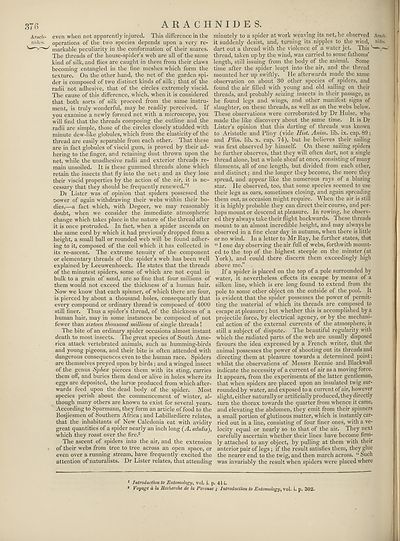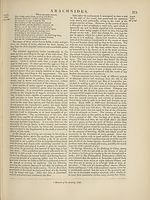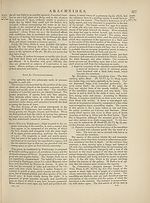Encyclopaedia Britannica > Volume 3, Anatomy-Astronomy
(384) Page 376
Download files
Complete book:
Individual page:
Thumbnail gallery: Grid view | List view

A R A C II N I D E S.
even when not apparently injured. This difference in the
operations of the two species depends upon a very re¬
markable peculiarity in the conformation of their snares.
The threads of the house-spider’s web are all of the same
kind of silk, and flies are caught in them from their claws
becoming entangled in the fine meshes which form the
texture. On the other hand, the net of the garden spi-
der is composed of two distinct kinds of silk; that of the
radii not adhesive, that of the circles extremely viscid.
The cause of this difference, .which, when it is considered
that both sorts of silk proceed from the same instru¬
ment, is truly wonderful, may be readily perceived. If
you examine a newly formed net with a microscope, you
wrill find that the threads composing the outline and the
radii are simple, those of the circles closely studded with
minute dew-like globules, which from the elasticity of the
thread are easily separable from each other. That these
are in fact globules of viscid gum, is proved by their ad¬
hering to the finger, and retaining dust thrown upon the
net, while the unadhesive radii and exterior threads re¬
main unsoiled. It is these gummed threads alone which
retain the insects that fly into the net; and as they lose
their viscid properties by the action of the air, it is ne¬
cessary that they should be frequently renewed.”1
Dr Lister was of opinion that spiders possessed the
power of again withdrawing their webs within their bo¬
dies,—a fact which, with Degeer, we may reasonably
doubt, when we consider the immediate atmospheric
change which takes place in the nature of the thread after
it is once protruded. In fact, when a spider ascends on
the same cord by which it had previously dropped from a
height, a small ball or rounded wreb will be found adher¬
ing to it, composed of the coil which it has collected in
its re-ascent. The extreme tenuity of the component
or elementary threads of the spider’s web has been well
explained by Leeuwenhoeck. He states that the threads
of the minutest spiders, some of which are not equal in
bulk to a grain of sand, are so fine that four millions of
them would not exceed the thickness of a human hair.
Now we know that each spinner, of which there are four,
is pierced by about a thousand holes, consequently that
every compound or ordinary thread-is composed of 4000
still finer. Thus a spider’s thread, of the thickness of a
human hair, may in some instances be composed of not
fewer than sixteen thousand millions of single threads !
The bite of an ordinary spider occasions almost instant
death to most insects. The great species of South Ame¬
rica attack vertebrated animals, such as humming-birds
and young pigeons, and their bite is often attended with
dangerous consequences even to the human race. Spiders
are themselves preyed upon by birds; and a winged insect
of the genus Sphex pierces them with its sting, carries
them off, and buries them dead or alive in holes where its
eggs are deposited, the larvae produced from which after¬
wards feed upon the dead body of the spider. Most
species perish about the commencement of winter, al¬
though many others are known to exist for several years.
According to Sparmann, they form an article of food to the
Bosjiesmen of Southern Africa; and Labillardiere relates,
that the inhabitants of New Caledonia eat with avidity
great quantities of a spider nearly an inch long (A. edulis),
which they roast over the fire.2
The ascent of spiders into the air, and the extension
of their webs from tree to tree across an open space, or
even over a running stream, have frequently excited the
attention ofnaturalists. Dr Lister relates, that attending
minutely to a spider at work weaving its net, he observed Arach-
it suddenly desist, and, turning its nipples to the wind, nides.
dart out a thread with the violence of a water jet. This
thread, taken up by the wind, was carried to some fathoms’
length, still issuing from the body of the animal. Some
time after the spider leapt into the air, and the thread
mounted her up swiftly. He afterwards made the same
observation on about 30 other species of spiders, and
found the air filled with young and old sailing on their
threads, and probably seizing insects in their passage, as
he found legs and wings, and other manifest signs of
slaughter, on these threads, as well as on the webs below.
These observations were corroborated by Dr Hulse, who
made the like discovery about the same time. It is Dr
Lister’s opinion that this darting of threads was known
to Aristotle and Pliny (vide Hist. Anim. lib. ix. cap. 89;
and Plin. lib. x. cap. 74), but he believes their sailing
was first observed by himself. On these sailing spiders
he further observes, that they will often dart, not a single
thread alone, but a whole sheaf at once, consisting of many
filaments, all of one length, but divided from each other,
and distinct; and the longer they become, the more they
spread, and appear like the numerous rays of a blazing
star. Lie observed, too, that some species seemed to use
their legs as oars, sometimes closing, and again spreading
them out, as occasion might require. When the air is still
it is highly probable they can direct their course, and per¬
haps mount or descend at pleasure. In rowing, he observ¬
ed they always take their flight backwards. These threads
mount* to an almost incredible height, and may always be
observed in a fine clear day in autumn, when there is little
or no wind. In a letter to Mr Ray, he further states, that
“ I one day observing the air full of webs, forthwith mount¬
ed to the top of the highest steeple on the minster (at
York), and could there discern them exceedingly high
above me.”
If a spider is placed on the top of a pole surrounded by
water, it nevertheless effects its escape by means of a
silken line, which is ere long found to extend from the
pole to some other object on the outside of the pool. It
is evident that the spider possesses the power of permit¬
ting the material of which its threads are composed to
escape at pleasure ; but whether this is accomplished by a
projectile force, by electrical agency, or by the mechani¬
cal action of the external currents of the atmosphere, is
still a subject of dispute. The beautiful regularity with
which the radiated parts of the web are usually disposed
favours the idea expressed by a French writer, that the
animal possesses the power of shooting out its threads and
directing them at pleasure towards a determined point;
whilst the observations of Messrs Rennie and Blackwall
indicate the necessity of a current of air as a moving force.
It appears, from the experiments of the latter gentleman,
that when spiders are placed upon an insulated twig sur¬
rounded by water, and exposed to a current of air, however
slight, either naturally or artificially produced, they directly
turn the thorax towards the quarter from whence it came,
and elevating the abdomen, they emit from their spinners
a small portion of glutinous matter, which is instantly car¬
ried out in a line, consisting of four finer ones, with a ve¬
locity equal or nearly so to that of the air. They next
carefully ascertain whether their lines have become firm¬
ly attached to any object, by pulling at them with their
anterior pair of legs ; if the result satisfies them, they glue
the nearer end to the twig, and then march across. “ Such
was invariably the result when spiders were placed where
1 Introduction to Entomology, vol. i. p. 411.
2 Voyage d la Recherche de la Perouse ; Introduction to Entomology, vol. i. p. 302.
even when not apparently injured. This difference in the
operations of the two species depends upon a very re¬
markable peculiarity in the conformation of their snares.
The threads of the house-spider’s web are all of the same
kind of silk, and flies are caught in them from their claws
becoming entangled in the fine meshes which form the
texture. On the other hand, the net of the garden spi-
der is composed of two distinct kinds of silk; that of the
radii not adhesive, that of the circles extremely viscid.
The cause of this difference, .which, when it is considered
that both sorts of silk proceed from the same instru¬
ment, is truly wonderful, may be readily perceived. If
you examine a newly formed net with a microscope, you
wrill find that the threads composing the outline and the
radii are simple, those of the circles closely studded with
minute dew-like globules, which from the elasticity of the
thread are easily separable from each other. That these
are in fact globules of viscid gum, is proved by their ad¬
hering to the finger, and retaining dust thrown upon the
net, while the unadhesive radii and exterior threads re¬
main unsoiled. It is these gummed threads alone which
retain the insects that fly into the net; and as they lose
their viscid properties by the action of the air, it is ne¬
cessary that they should be frequently renewed.”1
Dr Lister was of opinion that spiders possessed the
power of again withdrawing their webs within their bo¬
dies,—a fact which, with Degeer, we may reasonably
doubt, when we consider the immediate atmospheric
change which takes place in the nature of the thread after
it is once protruded. In fact, when a spider ascends on
the same cord by which it had previously dropped from a
height, a small ball or rounded wreb will be found adher¬
ing to it, composed of the coil which it has collected in
its re-ascent. The extreme tenuity of the component
or elementary threads of the spider’s web has been well
explained by Leeuwenhoeck. He states that the threads
of the minutest spiders, some of which are not equal in
bulk to a grain of sand, are so fine that four millions of
them would not exceed the thickness of a human hair.
Now we know that each spinner, of which there are four,
is pierced by about a thousand holes, consequently that
every compound or ordinary thread-is composed of 4000
still finer. Thus a spider’s thread, of the thickness of a
human hair, may in some instances be composed of not
fewer than sixteen thousand millions of single threads !
The bite of an ordinary spider occasions almost instant
death to most insects. The great species of South Ame¬
rica attack vertebrated animals, such as humming-birds
and young pigeons, and their bite is often attended with
dangerous consequences even to the human race. Spiders
are themselves preyed upon by birds; and a winged insect
of the genus Sphex pierces them with its sting, carries
them off, and buries them dead or alive in holes where its
eggs are deposited, the larvae produced from which after¬
wards feed upon the dead body of the spider. Most
species perish about the commencement of winter, al¬
though many others are known to exist for several years.
According to Sparmann, they form an article of food to the
Bosjiesmen of Southern Africa; and Labillardiere relates,
that the inhabitants of New Caledonia eat with avidity
great quantities of a spider nearly an inch long (A. edulis),
which they roast over the fire.2
The ascent of spiders into the air, and the extension
of their webs from tree to tree across an open space, or
even over a running stream, have frequently excited the
attention ofnaturalists. Dr Lister relates, that attending
minutely to a spider at work weaving its net, he observed Arach-
it suddenly desist, and, turning its nipples to the wind, nides.
dart out a thread with the violence of a water jet. This
thread, taken up by the wind, was carried to some fathoms’
length, still issuing from the body of the animal. Some
time after the spider leapt into the air, and the thread
mounted her up swiftly. He afterwards made the same
observation on about 30 other species of spiders, and
found the air filled with young and old sailing on their
threads, and probably seizing insects in their passage, as
he found legs and wings, and other manifest signs of
slaughter, on these threads, as well as on the webs below.
These observations were corroborated by Dr Hulse, who
made the like discovery about the same time. It is Dr
Lister’s opinion that this darting of threads was known
to Aristotle and Pliny (vide Hist. Anim. lib. ix. cap. 89;
and Plin. lib. x. cap. 74), but he believes their sailing
was first observed by himself. On these sailing spiders
he further observes, that they will often dart, not a single
thread alone, but a whole sheaf at once, consisting of many
filaments, all of one length, but divided from each other,
and distinct; and the longer they become, the more they
spread, and appear like the numerous rays of a blazing
star. Lie observed, too, that some species seemed to use
their legs as oars, sometimes closing, and again spreading
them out, as occasion might require. When the air is still
it is highly probable they can direct their course, and per¬
haps mount or descend at pleasure. In rowing, he observ¬
ed they always take their flight backwards. These threads
mount* to an almost incredible height, and may always be
observed in a fine clear day in autumn, when there is little
or no wind. In a letter to Mr Ray, he further states, that
“ I one day observing the air full of webs, forthwith mount¬
ed to the top of the highest steeple on the minster (at
York), and could there discern them exceedingly high
above me.”
If a spider is placed on the top of a pole surrounded by
water, it nevertheless effects its escape by means of a
silken line, which is ere long found to extend from the
pole to some other object on the outside of the pool. It
is evident that the spider possesses the power of permit¬
ting the material of which its threads are composed to
escape at pleasure ; but whether this is accomplished by a
projectile force, by electrical agency, or by the mechani¬
cal action of the external currents of the atmosphere, is
still a subject of dispute. The beautiful regularity with
which the radiated parts of the web are usually disposed
favours the idea expressed by a French writer, that the
animal possesses the power of shooting out its threads and
directing them at pleasure towards a determined point;
whilst the observations of Messrs Rennie and Blackwall
indicate the necessity of a current of air as a moving force.
It appears, from the experiments of the latter gentleman,
that when spiders are placed upon an insulated twig sur¬
rounded by water, and exposed to a current of air, however
slight, either naturally or artificially produced, they directly
turn the thorax towards the quarter from whence it came,
and elevating the abdomen, they emit from their spinners
a small portion of glutinous matter, which is instantly car¬
ried out in a line, consisting of four finer ones, with a ve¬
locity equal or nearly so to that of the air. They next
carefully ascertain whether their lines have become firm¬
ly attached to any object, by pulling at them with their
anterior pair of legs ; if the result satisfies them, they glue
the nearer end to the twig, and then march across. “ Such
was invariably the result when spiders were placed where
1 Introduction to Entomology, vol. i. p. 411.
2 Voyage d la Recherche de la Perouse ; Introduction to Entomology, vol. i. p. 302.
Set display mode to:
![]() Universal Viewer |
Universal Viewer | ![]() Mirador |
Large image | Transcription
Mirador |
Large image | Transcription
Images and transcriptions on this page, including medium image downloads, may be used under the Creative Commons Attribution 4.0 International Licence unless otherwise stated. ![]()
| Encyclopaedia Britannica > Encyclopaedia Britannica > Volume 3, Anatomy-Astronomy > (384) Page 376 |
|---|
| Permanent URL | https://digital.nls.uk/193762340 |
|---|
| Attribution and copyright: |
|
|---|---|
| Shelfmark | EB.16 |
|---|---|
| Description | Ten editions of 'Encyclopaedia Britannica', issued from 1768-1903, in 231 volumes. Originally issued in 100 weekly parts (3 volumes) between 1768 and 1771 by publishers: Colin Macfarquhar and Andrew Bell (Edinburgh); editor: William Smellie: engraver: Andrew Bell. Expanded editions in the 19th century featured more volumes and contributions from leading experts in their fields. Managed and published in Edinburgh up to the 9th edition (25 volumes, from 1875-1889); the 10th edition (1902-1903) re-issued the 9th edition, with 11 supplementary volumes. |
|---|---|
| Additional NLS resources: |
|

